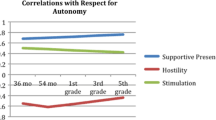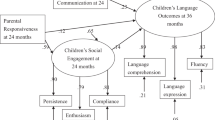Abstract
Contextual variations in mother-child and father-child verbal communication were examined among 80 U.S. families from Kansas who were predominately Caucasian (85%) and middle-class. There were 41 girls and 39 boys between 15- and 18-months-old observed with their mothers and fathers in separate play and caregiving laboratory situations. Parent and child behaviors were coded for verbal initiation and response strategies. MANOVA’s revealed more differences between mother’s and father’s verbal communication strategies in the play context than the caregiving context. Boy’s and girl’s verbal communication was relatively similar across contexts. The interactions between gender and context are discussed in relation to gender role development in the family.
Similar content being viewed by others
References
Ainsworth, M., Bell, S. M., & Stayton, D. J. (1991). Infant-mother attachment and social development: Socialization as a product of reciprocal responsiveness to signals. In M. Woodhead, R. Carr, & P. Light (Eds.), Becoming a person (pp. 30–55). London: Routledge.
Aldrich, N. J., & Tenenbaum, H. R. (2006). Sadness, anger, and frustration: Gendered patterns in early adolescents’ and their parents’ emotion talk. Sex Roles, 55, 775–785.
Beall, A. E. (1993). A social constructionist view of gender. In A. E. Beall & R. J. Sternberg (Eds.), The psychology of gender (pp. 127–147). New York: Guilford.
Black, B., & Logan, A. (1995). Links between communication patterns in mother-child, father-child, and child-peer interactions and children’s social competence. Child Development, 65, 255–271.
Bonny, J. F., Kelley, M. L., & Levant, R. F. (1999). A model of father’s involvement in child care in dual-earner families. Journal of Family Psychology, 13, 401–415.
Bornstein, M. H., Tamis-LeMonda, C. S., & Haynes, O. M. (1999). First words in the second year: Continuity, stability, and models of concurrent and predictive correspondence in vocabulary and verbal responsiveness across age and context. Infant Behavior and Development, 22, 65–85.
Caldera, Y. M., Huston, A. C., & O’Brien, M. (1989). Social interaction and play patterns of parents and toddlers with feminine, masculine, and neutral toys. Child Development, 60, 70–76.
Cherry, L., & Lewis, M. (1976). Mothers and two-year-olds: A study of sex-differentiated aspects of verbal interaction. Developmental Psychology, 12, 278–282.
Crockenberg, S., & Litman, C. (1990). Autonomy as competence in 2-year-olds: Maternal Correlates of child defiance, compliance, and self-assertion. Developmental Psychology, 26, 961–971.
Deaux, K., & Major, B. (1987). Putting gender into context: An interactive model of gender-related behavior. Psychological Review, 94, 369–389.
Drewes, A. A. (2005). Play in selected cultures: Diversity and universality. In E. Gil & A. A. Drewes (Eds.), Cultural issues in play therapy (pp. 26–71). New York: Guilford.
Dunn, J., & Brown, J. (1994). Affect expression in the family, children’s understanding of emotions, and their interactions with others. Merrill-Palmer Quarterly, 40, 120–137.
Dunn, J., Bretherton, I., & Munn, P. (1987). Conversations about feeling states between mothers and their young children. Developmental Psychology, 23, 132–139.
Eagly, A. H. (1987). Sex differences in social behavior: A social-role interpretation. Hillsdale: Lawrence Erlbaum Associates.
Eagly, A. H., & Diekman, A. (2003). The malleability of sex differences in response to changing social roles. In L. G. Aspinwall & U. M. Staudinger (Eds.), A psychology of human strengths: Fundamental questions and future directions for a positive psychology (pp. 103–115). Washington, DC: American Psychological Association.
Eagly, A. H., Wood, W., & Diekman, A. (2000). Social role theory of sex differences and similarities: A current appraisal. In T. Eckes & H. M. Trautner (Eds.), The developmental social psychology of gender (pp. 123–174). Mahwah: Erlbaum.
Feldman, R. (2003). Infant-mother and infant father synchrony: The coregulation of positive arousal. Infant Mental Health Journal, 24, 1–23.
Feldman, R., Greenbaum, C. W., & Yirmiya, N. (1999). Mother-infant affect synchrony as an antecedent of the emergence of self-control. Developmental Psychology, 35, 223–231.
Frankel, M. T., & Rollins, H. A., Jr. (1983). Does mother know best? Mothers and fathers interaction with preschool sons and daughters. Developmental Psychology, 19, 694–702.
Gralinski, J. H., & Kopp, C. B. (1993). Everyday rules for behavior: Mothers’ requests to young children. Developmental Psychology, 3, 573–584.
Grusec, J. E., & Davidov, M. (2007). Socialization in the family: The roles of parents. In J. E. Grusec & P. D. Hastings (Eds.), Handbook of socialization (pp. 284–308). New York: Guilford.
Hazen, N. L., & Black, B. (1989). Preschool peer communications skills: The role of social status and interaction context. Child Development, 60, 867–876.
Heimann, M., Strid, K., Smith, L., Tjus, T., Ulvund, S. E., & Meltzoff, A. N. (2006). Exploring the relation between memory, gestural communication, and the emergence of language in infancy: A longitudinal study. Infant and Child Development, 15, 233–249.
Hossain, Z., & Roopnarine, J. (1994). African-American fathers’ involvement with infants: Relationship to their functioning style, support, education, and income. Infant Behavior and Development, 17, 175–184.
Kelly, J. R., & Hutson-Comeaux, S. L. (1999). Gender-emotion stereotypes are context specific. Sex Roles, 40, 107–120.
LaFrance, M., Hecht, M. A., & Paluck, E. L. (2003). The contingent smile: A meta-analysis of sex differences in smiling. Psychological Bulletin, 129, 305–334.
Leaper, C., & Gleason, J. B. (1996). The relationship of play activity and gender to parent and child sex-typed communication. International Journal of Behavioral Development, 19, 689–703.
Leaper, C., Anderson, K. J., & Sanders, P. (1998). Moderators of gender effects on parents’ talk to their children: A meta-analysis. Developmental Psychology, 34, 3–27.
Lindsey, E. W., & Mize, J. (2001). Contextual differences in parent-child play: Implications for children’s gender role development. Sex Roles, 44, 155–176.
Lindsey, E. W., & Mize, J. (2000). Parent-child pretense and physical play: Links to children’s social competence. Merrill-Palmer Quarterly, 46, 565–590.
Lindsey, E. W., Mize, J., & Pettit, G. S. (1997). Differential play patterns of mothers and fathers of sons and daughters: Consequences for children’s gender role development. Sex Roles, 37, 643–661.
Lytton, H., & Romney, D. M. (1991). Parents’ differential socialization of boys and girls: A meta-analysis. Psychological Bulletin, 109, 267–296.
McHale, S. M., Crouter, A. C., & Whiteman, S. D. (2003). The family contexts of gender development in childhood and adolescence. Review of Social Development, 12, 125–151.
Myers, A. E. (1966). Simplex structure in the grading of essay tests. Educational and Psychological Measurement, 26, 41–54.
NICHD Early Child Care Research Network. (2006). Child care and child development: Results from the the nichd study of early child care and youth development. Guilford Publications.
O’Brien, M., & Nagle, K. J. (1987). Parents’ speech to toddlers: The effect of play context. Journal of Child Language, 14, 269–279.
Pellegrini, A. D., & Perlmutter, J. C. (1989). Classroom contextual effects on children’s play. Developmental Psychology, 25, 289–296.
Pettit, G. S., Brown, E. G., Mize, J., & Lindsey, E. W. (1998). Mothers’ and fathers’ socialization behaviors in three contexts: Links with children’s peer competence. Merrill-Palmer Quarterly, 44, 173–193.
Renk, K., Roberts, R., Roddenberry, A., Luick, M., Hillhouse, S., Meehan, C., et al. (2003). Mothers, fathers, gender role, and time parents spend with their children. Sex Roles, 48, 305–315.
Tamis-LeMonda, C. S., Shannon, J. D., Cabrera, N. J., & Lamb, M. E. (2004). Fathers and mothers at play with their 2-and 3-year-olds: contributions to language and cognitive development. Child Development, 75, 1806–20.
Tannen, D. (1994). Gender and discourse. New York: Oxford University Press.
Walden, T. A., & Baxter, A. (1989). The effect of context and age on social referencing. Child Development, 60, 1511–1518.
Wood, W., & Eagly, A. H. (2002). A cross-cultural analysis of the behavior of women and men: Implications for the origins of sex differences. Psychological Bulletin, 128, 699–727.
Acknowledgements
The authors would like to thank Laura Villa, Kim Kerksiek, Elaine Willerton, Jennifer Gomez, Mindy Rainbolt, Kelly Hardin, Carrie Blair, Alex Miller, and Shonna Blair for their help in data coding. We are grateful to the children, parents and children who participated in the research.
Author information
Authors and Affiliations
Corresponding author
Rights and permissions
About this article
Cite this article
Lindsey, E.W., Cremeens, P.R. & Caldera, Y.M. Gender Differences in Mother-toddler and Father-toddler Verbal Initiations and Responses during a Caregiving and Play Context. Sex Roles 63, 399–411 (2010). https://doi.org/10.1007/s11199-010-9803-5
Published:
Issue Date:
DOI: https://doi.org/10.1007/s11199-010-9803-5




